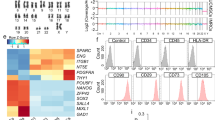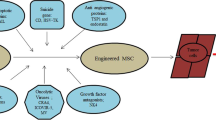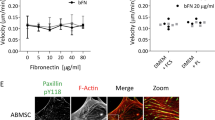Abstract
Umbilical cord matrix stem (UCMS) cells are unique stem cells derived from Wharton's jelly, which have been shown to express genes characteristic of primitive stem cells. To test the safety of these cells, human UCMS cells were injected both intravenously and subcutaneously in large numbers into severe combined immunodeficiency (SCID) mice and multiple tissues were examined for evidence of tumor formation. UCMS cells did not form gross or histological teratomas up to 50 days posttransplantation. Next, to evaluate whether UCMS cells could selectively engraft in xenotransplanted tumors, MDA 231 cells were intravenously transplanted into SCID mice, followed by intravenous transplantation of UCMS cells 1 and 2 weeks later. UCMS cells were found near or within lung tumors but not in other tissues. Finally, UCMS cells were engineered to express human interferon beta – designated ‘UCMS−IFN-β’. UCMS−IFN-β cells were intravenously transplanted at multiple intervals into SCID mice bearing MDA 231 tumors and their effect on tumors was examined. UCMS−IFN-β cells significantly reduced MDA 231 tumor burden in SCID mouse lungs indicated by wet weight. These results clearly indicate safety and usability of UCMS cells in cancer gene therapy. Thus, UCMS cells can potentially be used for targeted delivery of cancer therapeutics.
This is a preview of subscription content, access via your institution
Access options
Subscribe to this journal
Receive 12 print issues and online access
$259.00 per year
only $21.58 per issue
Buy this article
- Purchase on Springer Link
- Instant access to full article PDF
Prices may be subject to local taxes which are calculated during checkout





Similar content being viewed by others
Abbreviations
- DMEM:
-
Dulbecco's modified Eagle's medium
- DMSO:
-
dimethylsulfoxide
- EDTA:
-
ethylenediaminetetraacetic acid
- ESCs:
-
embryonic stem cells
- FBS:
-
fetal bovine serum
- HEPA:
-
high-efficiency particulate air
- IACUC:
-
institutional animal care and use committees
- IBC:
-
institutional biosafety committee
- IFN-β:
-
interferon beta
- PBS:
-
phosphate-buffered saline
- SCID:
-
severe combined immunodeficiency
- SP-DiI:
-
sulfonated derivatives of dialkyl indol dye
- UCMS cells:
-
umbilical cord matrix stem cells
- UCMS−IFN-β cells:
-
interferon-beta-expressing UCMS cells
- MDA 231 cells:
-
MD Anderson 231 human breast carcinoma cells
References
Mitchell KE, Weiss ML, Mitchell BM, Martin P, Davis D, Morales L et al. Matrix cells from Wharton's jelly form neurons and glia. Stem Cells 2003; 21: 50–60.
Karahuseyinoglu S, Cinar O, Kilic E, Kara F, Akay GG, Demiralp DO et al. Biology of stem cells in human umbilical cord stroma: in situ and in vitro surveys. Stem Cells 2007; 25: 319–331.
Weiss ML, Medicetty S, Bledsoe AR, Rachakatla RS, Choi M, Merchav S et al. Human umbilical cord matrix stem cells: preliminary characterization and effect of transplantation in a rodent model of Parkinson's disease. Stem Cells 2006; 24: 781–792.
Fu YS, Cheng YC, Lin MY, Cheng H, Chu PM, Chou SC et al. Conversion of human umbilical cord mesenchymal stem cells in Wharton's jelly to dopaminergic neurons in vitro: potential therapeutic application for parkinsonism. Stem Cells 2006; 24: 115–124.
Medicetty S, Bledsoe AR, Fahrenholtz CB, Troyer D, Weiss ML . Transplantation of pig stem cells into rat brain: proliferation during the first 8 weeks. Exp Neurol 2004; 190: 32–41.
Weiss ML, Mitchell KE, Hix JE, Medicetty S, El-Zarkouny SZ, Grieger D et al. Transplantation of porcine umbilical cord matrix cells into the rat brain. Exp Neurol 2003; 182: 288–299.
Carlin R, Davis D, Weiss M, Schultz B, Troyer D . Expression of early transcription factors Oct4, Sox2 and Nanog by porcine umbilical cord (PUC) matrix cells. Reprod Biol Endocrinol 2006; 4: 8.
Conconi MT, Burra P, Di LR, Calore C, Turetta M, Bellini S et al. CD105(+) cells from Wharton's jelly show in vitro and in vivo myogenic differentiative potential. Int J Mol Med 2006; 18: 1089–1096.
Wang HS, Hung SC, Peng ST, Huang CC, Wei HM, Guo YJ et al. Mesenchymal stem cells in the Wharton's jelly of the human umbilical cord. Stem Cells 2004; 22: 1330–1337.
Hoerstrup SP, Kadner A, Breymann C, Maurus CF, Guenter CI, Sodian R et al. Living, autologous pulmonary artery conduits tissue engineered from human umbilical cord cells. Ann Thorac Surg 2002; 74: 46–52.
Aboody KS, Brown A, Rainov NG, Bower KA, Liu S, Yang W et al. Neural stem cells display extensive tropism for pathology in adult brain: evidence from intracranial gliomas. Proc Natl Acad Sci USA 2000; 97: 12846–12851.
Studeny M, Marini FC, Champlin RE, Zompetta C, Fidler IJ, Andreeff M . Bone marrow-derived mesenchymal stem cells as vehicles for interferon-beta delivery into tumors. Cancer Res 2002; 62: 3603–3608.
Brown AB, Yang W, Schmidt NO, Carroll R, Leishear KK, Rainov NG et al. Intravascular delivery of neural stem cell lines to target intracranial and extracranial tumors of neural and non-neural origin. Hum Gene Ther 2003; 14: 1777–1785.
Nakamizo A, Marini F, Amano T, Khan A, Studeny M, Gumin J et al. Human bone marrow-derived mesenchymal stem cells in the treatment of gliomas. Cancer Res 2005; 65: 3307–3318.
Studeny M, Marini FC, Dembinski JL, Zompetta C, Cabreira-Hansen M, Bekele BN et al. Mesenchymal stem cells: potential precursors for tumor stroma and targeted-delivery vehicles for anticancer agents. J Natl Cancer Inst 2004; 96: 1593–1603.
Chawla-Sarkar M, Leaman DW, Borden EC . Preferential induction of apoptosis by interferon (IFN)-beta compared with IFN-alpha2: correlation with TRAIL/Apo2L induction in melanoma cell lines. Clin Cancer Res 2001; 7: 1821–1831.
Lokshin A, Mayotte JE, Levitt ML . Mechanism of interferon beta-induced squamous differentiation and programmed cell death in human non-small-cell lung cancer cell lines. J Natl Cancer Inst 1995; 87: 206–212.
Johns TG, Mackay IR, Callister KA, Hertzog PJ, Devenish RJ, Linnane AW . Antiproliferative potencies of interferons on melanoma cell lines and xenografts: higher efficacy of interferon beta. J Natl Cancer Inst 1992; 84: 1185–1190.
Wong VL, Rieman DJ, Aronson L, Dalton BJ, Greig R, Anzano MA . Growth-inhibitory activity of interferon-beta against human colorectal carcinoma cell lines. Int J Cancer 1989; 43: 526–530.
Fraker LD, Halter SA, Forbes JT . Growth inhibition by retinol of a human breast carcinoma cell line in vitro and in athymic mice. Cancer Res 1984; 44 (12 Part 1): 5757–5763.
Arnhold S, Klein H, Semkova I, Addicks K, Schraermeyer U . Neurally selected embryonic stem cells induce tumor formation after long-term survival following engraftment into the subretinal space. Invest Ophthalmol Vis Sci 2004; 45: 4251–4255.
Ishikawa T, Nakayama S, Nakagawa T, Horiguchi K, Misawa H, Kadowaki M et al. Characterization of in vitro gutlike organ formed from mouse embryonic stem cells. Am J Physiol Cell Physiol 2004; 286: C1344–C1352.
Thomson JA, Marshall VS . Primate embryonic stem cells. Curr Top Dev Biol 1998; 38: 133–165.
Wakitani S, Takaoka K, Hattori T, Miyazawa N, Iwanaga T, Takeda S et al. Embryonic stem cells injected into the mouse knee joint form teratomas and subsequently destroy the joint. Rheumatology (Oxford) 2003; 42: 162–165.
Juang SH, Wei SJ, Hung YM, Hsu CY, Yang DM, Liu KJ et al. IFN-beta induces caspase-mediated apoptosis by disrupting mitochondria in human advanced stage colon cancer cell lines. J Interferon Cytokine Res 2004; 24: 231–243.
Buchwalder PA, Buclin T, Trinchard I, Munafo A, Biollaz J . Pharmacokinetics and pharmacodynamics of IFN-beta 1a in healthy volunteers. J Interferon Cytokine Res 2000; 20: 857–866.
Einhorn S, Grander D . Why do so many cancer patients fail to respond to interferon therapy? J Interferon Cytokine Res 1996; 16: 275–281.
Salmon P, Le Cotonnec JY, Galazka A, bdul-Ahad A, Darragh A . Pharmacokinetics and pharmacodynamics of recombinant human interferon-beta in healthy male volunteers. J Interferon Cytokine Res 1996; 16: 759–764.
Dmitriev I, Krasnykh V, Miller CR, Wang M, Kashentseva E, Mikheeva G et al. An adenovirus vector with genetically modified fibers demonstrates expanded tropism via utilization of a coxsackie virus and adenovirus receptor-independent cell entry mechanism. J Virol 1998; 72: 9706–9713.
Koizumi N, Mizuguchi H, Hosono T, Ishii-Watabe A, Uchida E, Utoguchi N et al. Efficient gene transfer by fiber-mutant adenoviral vectors containing RGD peptide. Biochim Biophys Acta 2001; 1568: 13–20.
Mizuguchi H, Koizumi N, Hosono T, Utoguchi N, Watanabe Y, Kay MA et al. A simplified system for constructing recombinant adenoviral vectors containing heterologous peptides in the HI loop of their fiber knob. Gene Therapy 2001; 8: 730–735.
Tlsty TD, Hein PW . Know thy neighbor: stromal cells can contribute oncogenic signals. Curr Opin Genet Dev 2001; 11: 54–59.
van Kempen LC, Ruiter DJ, van Muijen GN, Coussens LM . The tumor microenvironment: a critical determinant of neoplastic evolution. Eur J Cell Biol 2003; 82: 539–548.
Nakamura K, Ito Y, Kawano Y, Kurozumi K, Kobune M, Tsuda H et al. Antitumor effect of genetically engineered mesenchymal stem cells in a rat glioma model. Gene Therapy 2004; 11: 1155–1164.
Azizi SA, Stokes D, Augelli BJ, DiGirolamo C, Prockop DJ . Engraftment and migration of human bone marrow stromal cells implanted in the brains of albino rats – similarities to astrocyte grafts. Proc Natl Acad Sci USA 1998; 95: 3908–3913.
Kopen GC, Prockop DJ, Phinney DG . Marrow stromal cells migrate throughout forebrain and cerebellum, and they differentiate into astrocytes after injection into neonatal mouse brains. Proc Natl Acad Sci USA 1999; 96: 10711–10716.
Acknowledgements
We thank Marla Pyle for technical assistance and manuscript proofreading, Matt Martinez and Erin Miller for laboratory assistance in tissue sectioning and in vitro studies. This work represents contributions from the National Cancer Institute (Grant nos. CA-1094551 and CA116199-01 for FCM), grants from the Susan G. Komen Breast Cancer Foundation, NIH NS 34160, Terry C Johnson Cancer Center, Kansas State Legislature and the Kansas Agricultural Experiment Station.
Author information
Authors and Affiliations
Corresponding author
Rights and permissions
About this article
Cite this article
Rachakatla, R., Marini, F., Weiss, M. et al. Development of human umbilical cord matrix stem cell-based gene therapy for experimental lung tumors. Cancer Gene Ther 14, 828–835 (2007). https://doi.org/10.1038/sj.cgt.7701077
Received:
Revised:
Accepted:
Published:
Issue Date:
DOI: https://doi.org/10.1038/sj.cgt.7701077
Keywords
This article is cited by
-
Inhibition of growth of Asian keloid cells with human umbilical cord Wharton’s jelly stem cell-conditioned medium
Stem Cell Research & Therapy (2020)
-
Genetically engineered mesenchymal stem cells: targeted delivery of immunomodulatory agents for tumor eradication
Cancer Gene Therapy (2020)
-
Large-Scale Automated Hollow-Fiber Bioreactor Expansion of Umbilical Cord-Derived Human Mesenchymal Stromal Cells for Neurological Disorders
Neurochemical Research (2020)
-
Mesenchymal stem cells in preclinical cancer cytotherapy: a systematic review
Stem Cell Research & Therapy (2018)
-
Induction of Immunogenic Cell Death in Lymphoma Cells by Wharton’s Jelly Mesenchymal Stem Cell Conditioned Medium
Stem Cell Reviews and Reports (2017)



